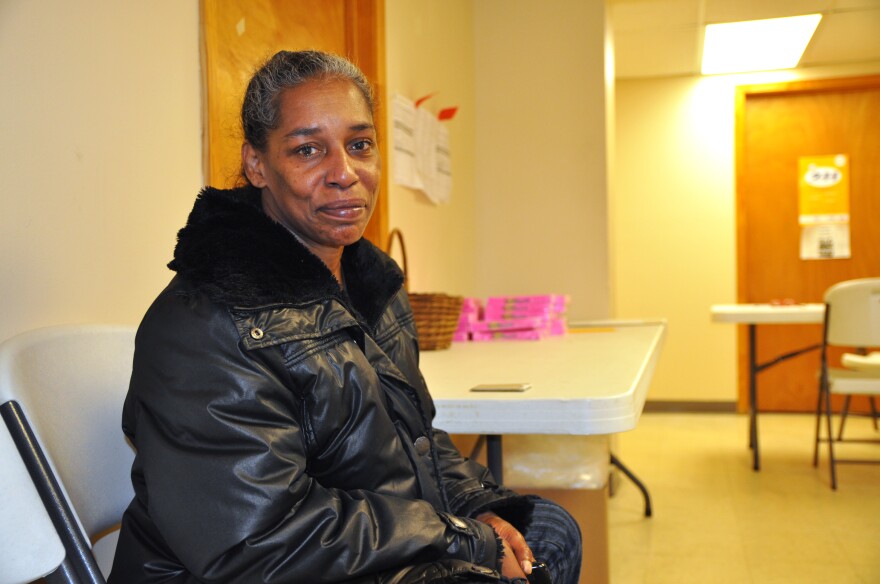When Sam Johnson helps people fill grocery carts at the food pantry he manages now, he notices that the items have been picked over more than usual.
“Normally we have meat. Chicken, we might have fish. But we ran out of meat that you can cook,” Johnson said.
Instead, a fold-out table offers a selection of canned chicken, SPAM and tuna in the basement on the grounds of the St. Elizabeth, Mother of John the Baptist Church, in north St. Louis.
In the past few years that Johnson has managed the pantry as a volunteer, he’s seen demand rise during the holidays and again in the summer. Now, he’s starting to see another group of newcomers: visitors who recently lost their public assistance benefits in the state’s latest round of cuts.
“A lot of individuals who we hadn’t seen in a while have started coming back,” Johnson said. “We had individuals who went from $300 all the way down to zero.”
Last year, the Missouri legislature voted to lift a federal waiver that allowed people to receive public food assistance, or SNAP, for more than three months while unemployed. The waiver can be put into place when state unemployment rates get particularly high or in areas where there is a surplus of labor. The work requirement only applies to people who do not have dependent children or a disability, and can be fulfilled with 80 hours a month of paid work, education or qualified work training.
On April 1, about 27,000 Missourians were cut from SNAP for not fulfilling those requirements, according to the state’s Department of Social Services. Cuts to another program, Temporary Assistance for Needy Families, also reduced the maximum amount of time a working family can receive cash assistance.
“Most people didn’t realize that their food stamps were cut. They hear about SNAP, but they don’t realize it until they get up to the counter that they don’t have what they normally have,” Johnson said.

For individuals, the cuts are devastating. In the waiting area for the food pantry, Catherine Scales, 48, said she also lost her benefits in April — a monthly allotment of $189. She lives a few blocks away from the church, raising three grandchildren ages 12, 8, and 4.
“I don’t have no food, that’s why I’m here,” she said, her voice cracking as she broke down in tears. “Anything from in-house care keeping, to a restaurant. I don’t care, I’ll do it, I’ll work."
Based on the way the law is written, Scales should still be able to receive food assistance because she has dependents and is actively looking for work. But Scales hasn’t appealed her case — she's still reeling from the shock of losing her benefits and says the process has led her to nearly give up.
“Every time I call down, everything is done computerized now. You don’t get to talk to a person. All they’ve got to do is look at my name, look in the system,” Scales said. “I’m trying, I really am. But it’s not helping.”
Some of the larger food pantries in the St. Louis area, including the Harvey Kornblum Jewish Food Pantry in St. Louis County and Circle of Concern in Valley Park, said it’s too early to tell how the cuts will affect their clients.
“To date, there’s not been much of an uptick. We’re really watching for this, but to date not a huge response from people seeking additional support or new clients,” said Cindy Miller, the executive director of Circle of Concern.
Personnel at the St. Louis Area Foodbank said a few pantries that they distribute food to have mentioned seeing a higher demand in the past month, but the need always increases around this time of year.
“When we historically see an uptick in demand is over those summer months when kids get out of school, and I think it’s going to be compounded in Missouri with the SNAP cuts,” said the food bank’s spokesperson Ryan Farmer.
In the summer, pantries may be contending with lower donations as well, because food drives tend to be scheduled for holidays in the winter months.
“When you start taking away benefits, that food has to get made up somewhere, and that falls on the back of shelters, soup kitchens and senior centers that we provide items to,” Farmer said.
Follow Durrie on Twitter: @durrieB.
If you or a family member may qualify for food assistance, the Information Center for Missouri's Family Support Division can be reached at 855-FSD-INFO (855-373-4636).


